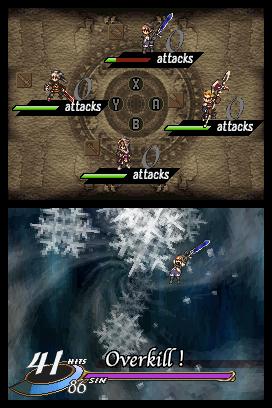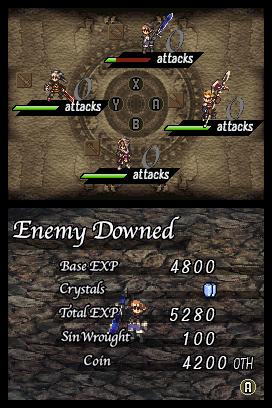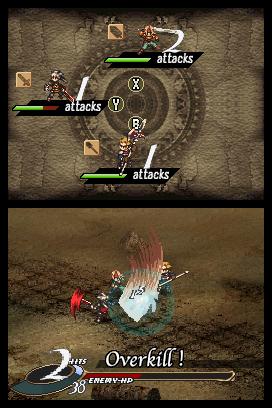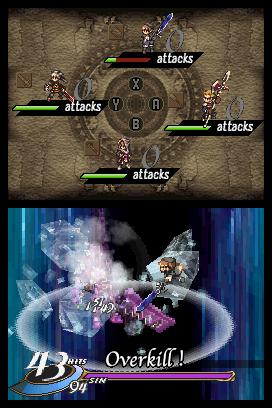
Kingdom Hearts: Birth By Sleep Review
Kingdom Hearts: Birth By Sleep was the long-anticipated game that fans have been waiting for, because it was the first time that the series saw its debut on the Sony's PlayStation Portable after only making appearances on either the PlayStation 2 or Nintendo's handheld consoles. Does the game stack up well to its console counterparts, or would you be better off just holding your breath after the rather disappointing 358/2 Days and holding out for a console release? Let's find out in RPGSite's review for Birth By Sleep.

With a story that takes place 10 years before the beginning of the original Kingdom Hearts, we are introduced to three Keyblade apprentices -- the young Ventus (voiced by Jesse McCartney who also provided the voice of Roxas in Kingdom Hearts II and the upcoming Re:coded), the female magic-user Aqua (voiced by Willa Holland), and Terra (voiced by Jason Dohring who provides the weakest acting of the bunch) -- all with the high endeavor of being selected to become a Keyblade Master, trained under the guiding hand of Master Eraqus (voiced by Mark Hamill), one of the last Keyblade masters in the world after a deadly war that nearly wiped out their entire existence.
Master Xehanort (voiced by Leonard Nimoy and who, along with the rest of these staple of characters, was featured in the bonus video featured at the end of Kingdom Hearts II: Final Mix+), suddenly disappears during Terra and Aqua's Mark of Mastery exam that determines the next Keyblade master, and the creatures known as the Unversed show up to wreak havoc on the unsuspecting populace. Terra and Aqua are sent of Eraqus to investigate how this all came to be and what exactly happened to Master Xehanort, and through the coercions of a perplexing figure, has Ventus chasing after them to make his own discoveries.

At this point, the game throws a refreshing wrench into the norm of the series. Here you are able to choose which character you actually want to go through the story with. Each character provides their own perspective of the sequence of events that take place during the game, along with their own strengths and weakness. For example, Ventus is agile but not very strong (ala Sora or Roxas), Terra is slow but powerful, and Aqua relies on the aforementioned range of magical abilities to dispach her foes, but can be weak to physical attacks.
After all these years playing Sora or someone like Sora, I found Aqua to be the best among the bunch specifically because it provided a little bit of challenge of being able to circle around your opponents and rely on a strategy of spell casting.
Terra, on the other hand, has to be one of the weakest characters to grace the series' roster. It isn't enough that he is attempting to fill the void of Riku as the big spoon in the bro-mance between him and Ven, but his entire arc is very predictable and at times kind of annoying.
The story can also be a little hit and miss at times. Between Square-Enix characters, the story really shines and you can see the sheer amount of work that went into the game. Things can get pretty intense especially towards the end of the game and makes it difficult to put the system down. However, when my Disney pals came waltzing in, the game lost almost all of its charm. You'd think they all jumped in a pool of devolution cream because their sheer amount of stupidity was so harrowing. Only until near the end of the game did the action really pick up and things quickly became exciting to witness that had me trying to forget the events that led up to that point, and (SPOILER ALERT) left the door open for a sequel.

Before we get to the controls, I want to talk to you all about the Options menu. One of the choices is the ability to install a portion of the game data onto your memory stick to allow the game to play a lot smoother - 200MB speeds up the combat; 400MB speeds up the combat, the time it takes to open the main menu, and the loading between areas; and 624MB speeds up virtually all the loading times in the game. For those who know how bad the loading times can be on the PSP, the choice is an easy one if you have the space to spare.
Now, I say to choose the third one because the Configuration screen in the main menu during the actual game offers you some pretty crazy choices. For example, you can choose the Color Depth from 16-bit to 32-bit to offer nearly 17 million more colors, along with a way to increase the CPU to accelerate the processor speed by 30%. As you can imagine, all of this comes at the expense of battery life, but the shorter loading screens kind of makes up for that, and you get a even better looking game to show for it.
The controls are pretty simple and intuitive. You use X to attack, Square to block or dodge, Triangle to use commands, Circle to jump, and L +R to lock onto an opponent. You can also hold L and R and move the analog stick to use Shotlock, which brings up an aiming reticle where you roll over targets and hit X to send a volley of ranged attacks ala Panzer Dragoon, something that Aqua is best suited for because of her powerful magic abilities. Using Shotlock uses your Focus bar that depletes after time while it is in use.

Attacking also fills up your Command Gauge which, when at 100%, activates a Finish attack. Using different moves to fill that gauge changes your Command Style which provides different attacks, such as using a Fire Slide at one point unlocks the Firestorm technique that unleashes a flurry of fire-based offensive maneuvers.
The lack of a second nub on the PSP is perhaps the biggest fault of this system, however. At times my hands felt a little cramped trying to get Ven to leap up into the air and deliver a combo to soaring enemies, and trying to quickly rotate the thumbstick in circles during one of the many hallmark QTE moments in the game was sometimes a chore. Hopefully with the hints towards the inclusion of a second analog for the PSP2 will make all of these issues go away.
Players can also decide what commands they want through the Edit Commands option in the menu screen. These are tied to the elements of Physical (such as Blitz or Strike Raid), Magical (such as Gravity and Blizzaga), and . Each of these commands can be leveled up to increase their power, eventually unlocking what the game calls an Auto-Ability. Each command has one of these, and these are basically added benefits that stay active even when you don't have the original command placed in your deck and can be toggled. For example, the first Auto-Ability you receive is Scan, or being able to see the life bars of your enemies on the top right of the screen. Later, you'll get auto-abilities that make enemies drop more loot, increase the maximum HP of the main character, and more.
The game also offers an option to synthesize commands together with items to create new commands through the Command Charge menu. I didn't find myself using this feature that much because I was basically picking up all of these creations around the environment beforehand.

To make up for the fact that you will basically be going on this long journey by your lonesome, the game introduces the Dimension Link, or D-Link system shortly after you leave Aqua behind to chase after Terra. This feature allows you to link up with your past and future friends around the game including Disney characters and borrow their powers. This feature also has its own dedicated gauge that only lets you use it for so long. You have to defeat enemies with your D-Link commands in order for them to drop emblems that refill the bar.
The art style by itself is some of the best you'll find on any PSP title or even most console exclusives, something the series is renowed for and certainly translates well to the small screen. Tetsuya Nomura's character designs are great to look at and . The visuals themselves go to show how exponentially more powerful a system the PSP is compared to the DS when you take a look at 358/2 Days -- the faces and movements are conducted very fluidly, and you'll easily find yourself getting lost in delight. The worlds themselves can be a little barren due to the PSP's dated hardware, and the Disney characters are as a whole are drawn with rather shoddy handiwork, it still provides a unique contrast to a lot of other games featured on the handheld.

To break up the story, the game also offers a range of minigames that can be played at the Mirage Arena. Players can take part of battles both online and offline whether through combat challenges between players and monsters, in a racing mode with karts, or even a Command Board mode that plays out like Monopoly.
The Command Board allows you a rather quick method to max out your entire reservoir of command moves in one sitting, along with the ability to acquire new moves and items that you may have not found outside of the game. Players take turns going around spaces on a board. The goal of the player is to land on different "properties" on the board and purchase them with their BP (the in-game currency). They then place one of their command moves from their deck that is dealt to them at the beginning of the game (and replenishes during the rounds), where they can then level them up with even more BP to make them more powerful and increases the amount of "rent" players have to give to the property owners. If they have more than enough BP, however, they can buy the panel that they landed on and steal it right out from under you.
Some of the other panels on the board offer bonuses such as BP, hidden items, or even an appearance of Disney's Pete who can either take money from other players or give free money to you. Players can set the rules of the game along with which board they want to play on, with the typical goal being to reach a certain level of BP and quickly get back to the starting panel before the other player does.
All of these minigames and challenges can be pretty fun excursions, and provides many, many more hours of enjoyment long after the game is over.

However, one of the bigger qualms I have about this title is that for what used to be the main baddies/mascots for the original games, the Heartless (or as they're known in this game, the Unversed), are sort of just dropped into the action out of nowhere without any sort of cutscene or plot diversion. In Kingdom Hearts I, for example, Sora stumbles upon these slimy creatures and basically goes nuts. In Kingdom Hearts II, Roxas is ambushed and goes nuts. In Kingdom Hearts: Birth By Sleep, Ven is just running around when they pop up and kinda steps on em without a second thought. Sure, you're supposed to make some sort of deduction that these Unversed have infected the world and you need to do something about them, but the opening story barely talks about them, and the other creatures themselves don't appear inside the throne room that Ven, Terra, and Aqua first do battle in during the exam.
I'm not saying every enemy in an RPG needs some sort of explanation to why exactly they exist in the first place, but considering how much emphasis the other entries into the series placed on the Heartless, I find it a little unusual that in this game, they have simply become little more than a part of the scenery than anything. They are justified towards the end of the game, but this game may not be the game you should recommend to newcomers of the series who aren't that familiar with the series' canon.
Another issue I have is that for this game, the Disney characters seem sort of an after-thought, something tacked on at the end of development with a few characters just so they can slap on the "Disney Interactive Studio" label on the box. Very few of the worlds that you will visit are actually based on the classic cartoons, and most of the characters on your journey are original designs from Square-Enix. Outside of Mickey Mouse, the lack of Disney characters for most of the key plot points makes it feel far less of a partnership. Heck, at least with the other games with Sora, you had Donald and Goofy with you for the entire ride to make it really feel like you were fighting alongside your childhood friends. Now, you're on your own, and aside from some excursions, you'll sneak a glance at Scrooge McDuck for a few seconds, but you'll quickly run into an Unversed and they'll chuck all that out the window.

Despite its flaws of a sometimes convoluted story, a rather weak Disney crossover attempt, and what can be called a fleeting charm during the middle of the story, there is a lot to appreciate about this game. Not only does it offer a very refreshing perspective for the series by allowing you to choose from three different characters to play through the main story with, but the visuals are actually on par with its PlayStation 2 counterparts. This game provides a high-degree of polish, and the music is great as always. It may not be as great in my mind as Kingdom Hearts or especially Kingdom Hearts II, but as a whole, you'd be hard-pressed to find a more enjoyable portable game this year, and it makes the wait for Kingdom Hearts III that much harder to bear.